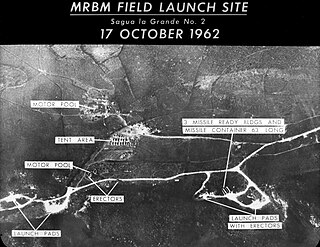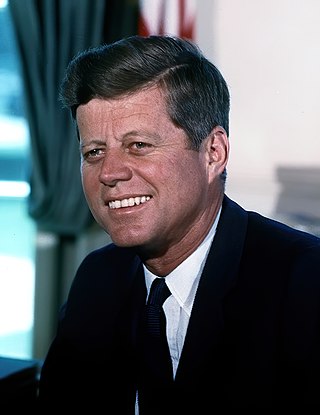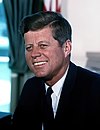
The Cuban Missile Crisis, also known as the October Crisis in Cuba, or the Caribbean Crisis, was a 13-day confrontation between the governments of the United States and the Soviet Union, when American deployments of nuclear missiles in Italy and Turkey were matched by Soviet deployments of nuclear missiles in Cuba. The crisis lasted from 16 to 28 October 1962. The confrontation is widely considered the closest the Cold War came to escalating into full-scale nuclear war.

Allen Welsh Dulles was an American lawyer who was the first civilian Director of Central Intelligence (DCI), and its longest serving director to date. As head of the Central Intelligence Agency (CIA) during the early Cold War, he oversaw the 1953 Iranian coup d'état, the 1954 Guatemalan coup d'état, the Lockheed U-2 aircraft program, the Project MKUltra mind control program and the Bay of Pigs Invasion in 1961. As a result of the failed invasion of Cuba, Dulles was fired by President John F. Kennedy.

Brinkmanship or brinksmanship is the practice of trying to achieve an advantageous outcome by pushing dangerous events to the brink of active conflict. The maneuver of pushing a situation with the opponent to the brink succeeds by forcing the opponent to back down and make concessions rather than risk engaging in a conflict that would no longer be beneficial to either side. That might be achieved through diplomatic maneuvers, by creating the impression that one is willing to use extreme methods rather than concede. The tactic occurs in international politics, foreign policy, labor relations, contemporary military strategy, terrorism, and high-stakes litigation.

On 1 May 1960, a United States U-2 spy plane was shot down by the Soviet Air Defence Forces while conducting photographic aerial reconnaissance deep inside Soviet territory. Flown by American pilot Francis Gary Powers, the aircraft had taken off from Peshawar, Pakistan, and crashed near Sverdlovsk, after being hit by a surface-to-air missile. Powers parachuted to the ground and was captured.

The Cold War (1953–1962) discusses the period within the Cold War from the end of the Korean War in 1953 to the Cuban Missile Crisis in 1962. Following the death of Joseph Stalin earlier in 1953, new leaders attempted to "de-Stalinize" the Soviet Union causing unrest in the Eastern Bloc and members of the Warsaw Pact. In spite of this there was a calming of international tensions, the evidence of which can be seen in the signing of the Austrian State Treaty reuniting Austria, and the Geneva Accords ending fighting in Indochina. However, this period of good happenings was only partial with an expensive arms race continuing during the period and a less alarming, but very expensive space race occurring between the two superpowers as well. The addition of African countries to the stage of cold war, such as the Democratic Republic of the Congo joining the Soviets, caused even more unrest in the West.

The Kennedy Doctrine refers to foreign policy initiatives of the 35th President of the United States, John Fitzgerald Kennedy, towards Latin America during his administration between 1961 and 1963. Kennedy voiced support for the containment of communism as well as the reversal of communist progress in the Western Hemisphere.

The Cuban Project, also known as Operation Mongoose, was an extensive campaign of terrorist attacks against civilians, and covert operations, carried out by the U.S. Central Intelligence Agency in Cuba. It was officially authorized on November 30, 1961 by U.S. President John F. Kennedy. The name "Operation Mongoose" was agreed to at a White House meeting on November 4, 1961.
In the United States, during the Cold War, the missile gap was the perceived superiority of the number and power of the USSR's missiles in comparison with those of the U.S.. The gap in the ballistic missile arsenals did not exist except in exaggerated estimates, made by the Gaither Committee in 1957 and in United States Air Force (USAF) figures. Even the contradictory CIA figures for the USSR's weaponry, which showed a clear advantage for the US, were far above the actual count. Like the bomber gap of only a few years earlier, it was soon demonstrated that the gap was entirely fictional.

Richard Mervin Bissell Jr. was an American Central Intelligence Agency officer responsible for major projects such as the U-2 spy plane and the Bay of Pigs Invasion. He is seen as one of the most important spymasters in CIA history.

John Fitzgerald Kennedy, often referred to as JFK, was an American politician who served as the 35th president of the United States from 1961 until his assassination in 1963. He was the youngest person elected president. Kennedy served at the height of the Cold War, and the majority of his foreign policy concerned relations with the Soviet Union and Cuba. A Democrat, Kennedy represented Massachusetts in both houses of the United States Congress prior to his presidency.

The Missiles of October is a 1974 docudrama made-for-television play about the Cuban Missile Crisis in October 1962. The title evokes the 1962 book The Guns of August by Barbara Tuchman about the missteps amongst the great powers and the failed chances to give an opponent a graceful way out, which led to World War I.

John F. Kennedy's tenure as the 35th president of the United States began with his inauguration on January 20, 1961, and ended with his assassination on November 22, 1963. Kennedy, a Democrat from Massachusetts, took office following his narrow victory over Republican incumbent vice president Richard Nixon in the 1960 presidential election. He was succeeded by Vice President Lyndon B. Johnson.

The inauguration of John F. Kennedy as the 35th president of the United States was held on Friday, January 20, 1961, at the East Portico of the United States Capitol in Washington, D.C. This was the 44th inauguration and marked the commencement of John F. Kennedy's and Lyndon B. Johnson's only term as president and vice president. Kennedy was assassinated 2 years, 306 days into this term, and Johnson succeeded to the presidency.

The American University speech, titled "A Strategy of Peace", was a commencement address delivered by United States President John F. Kennedy at the American University in Washington, D.C., on Monday, June 10, 1963. Widely considered one of the most powerful speeches Kennedy delivered, he not only outlined a plan to curb nuclear arms, but also "laid out a hopeful, yet realistic route for world peace at a time when the U.S. and Soviet Union faced the potential for an escalating nuclear arms race." In the speech, Kennedy announced his agreement to negotiations "toward early agreement on a comprehensive test ban treaty" and also announced, for the purpose of showing "good faith and solemn convictions", his decision to unilaterally suspend all U.S. atmospheric testing of nuclear weapons as long as all other nations would do the same. Noteworthy are his comments that the United States was seeking a goal of "complete disarmament" of nuclear weapons and his vow that America "will never start a war".
The United States foreign policy during the presidency of John F. Kennedy from 1961 to 1963 included diplomatic and military initiatives in Western Europe, Southeast Asia, and Latin America, all conducted amid considerable Cold War tensions with the Soviet Union and its satellite states in Eastern Europe. Kennedy deployed a new generation of foreign policy experts, dubbed "the best and the brightest". In his inaugural address Kennedy encapsulated his Cold War stance: "Let us never negotiate out of fear. But let us never fear to negotiate".

JFK and the Unspeakable: Why He Died and Why It Matters is a book by theologian and Catholic Worker James W. Douglass that analyzes the presidency of John F. Kennedy as well as the events surrounding his assassination. The book is drawn from many sources, including the Warren Report. The book's central thesis is that Kennedy was a cold warrior who turned to peace-making, and that as a result he was killed by his own security apparatus.
The presidency of Dwight D. Eisenhower began on January 20, 1953, when Dwight D. Eisenhower was inaugurated as the 34th president of the United States, and ended on January 20, 1961.
The United States foreign policy of the Dwight D. Eisenhower administration, from 1953 to 1961, focused on the Cold War with the Soviet Union and its satellites. The United States built up a stockpile of nuclear weapons and nuclear delivery systems to deter military threats and save money while cutting back on expensive Army combat units. A major uprising broke out in Hungary in 1956; the Eisenhower administration did not become directly involved, but condemned the military invasion by the Soviet Union. Eisenhower sought to reach a nuclear test ban treaty with the Soviet Union, but following the 1960 U-2 incident the Kremlin canceled a scheduled summit in Paris.
The following is a timeline of the presidency of John F. Kennedy from January 1, 1962, to December 31, 1962.
The following is a timeline of the presidency of John F. Kennedy from January 1, 1963, to November 22, 1963, upon his assassination and death.





















